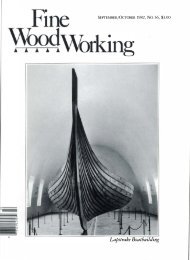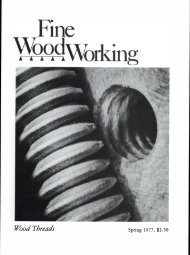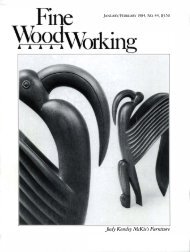NOVEMBER/DECEMBER 1983, No. 43, $3.50 Making ... - Wood Tools
NOVEMBER/DECEMBER 1983, No. 43, $3.50 Making ... - Wood Tools
NOVEMBER/DECEMBER 1983, No. 43, $3.50 Making ... - Wood Tools
Create successful ePaper yourself
Turn your PDF publications into a flip-book with our unique Google optimized e-Paper software.
Which Glue Do You Use?<br />
Chemical types, not brands, make the difference<br />
by George Mustoe<br />
T ike the alchemists' attempts to transmute base metal into<br />
L gold, much human effott has gone into the search for the<br />
perfea glue. This goal is probably as unrealistic as the dreams<br />
of alchemy, but the inventors' struggles have not been without<br />
reward: adhesives manufacruring is a big growth industry<br />
in the United States, and per-capita consumption is about<br />
40 lb. per year.<br />
<strong>No</strong>t surprisingly, "What kind of glue did you use?" is a<br />
frequent query heard whenever woodworkers gather. Unforrunately,<br />
these exchanges generate some old wives' tales,<br />
among them the colorful but incorrea assertion that cyanoacrylate<br />
"superglue" is derived from barnacles (FWW #37).<br />
Because wood is a relatively weak consttuction material,<br />
most adhesives produce bonds that are stronger than the surrounding<br />
lumber, so claims of extremely high sttength are<br />
seldom meaningful to the woodworker. Instead, the most impottant<br />
charaaeristics are setting rate, viscosiry, resistance to<br />
As water, flexibiliry, color, sandabiliry, and gap-filling properties.<br />
a<br />
woodworker who happens also to be a chemist, I've<br />
developed a keener than usual interest in the literally hundreds<br />
of glues sold today, discovering in the course of my<br />
research that only abour a dozen kinds are useful for woodworking.<br />
Within each category, I've found that different<br />
brands will usually perform equally, so the choice for a particular<br />
project is best made by understanding the chemical<br />
makeup and charaaeristics of the glues we use.<br />
In this article, I'll cover those glues that are best suited to<br />
general woodworking. In a second article, I'll talk about<br />
epoxies, hot-melt glues, cyanoacrylates and contaa cements,<br />
all specialry glues that are usually more expensive, though not<br />
always better, than our old standbys.<br />
Protein glues-The natural world abounds with examples of<br />
sophisticated adhesives which display impressive tenaciry; barnacles<br />
and mussels, for example, cement themselves to beach<br />
rocks and ship bottoms with a substance that resists pro-<br />
. longed immersion in salt water. Though the chemistry of<br />
these natural adhesives is poorly understood, most sticky secretions<br />
are combinations of various complex proteins. Thus it<br />
is not surprising that early artisans discovered that the best<br />
raw materials for glue were protein-rich animal products such<br />
as skin, bone and blood.<br />
Today, despite the advent of modern synthetic adhesives,<br />
animal-protein glues are still common. They can be divided<br />
into three rypes: hide and bone glue, fish glue, and blood<br />
glue. Of the three, hide and bone glues are of the greatest<br />
interest to the woodworker. The use of fish glue, which is<br />
derived from the water-soluble proteins in fish skins, is limited<br />
to industry, mainly for attaching labels to bottles and occasionally<br />
as a tack-improving additive to white glue. Blood<br />
glues, once developed as water-resistant adhesives for early<br />
military aircraft, are made by dispersing beef or pig blood in<br />
62<br />
water, with wood dust, lime or sodium silicate added as<br />
thickening. They're most often encountered in vintage plywood,<br />
but are praaically impossible to buy today and have<br />
no significant advantages over readily available synthetics.<br />
can<br />
Hide and bone glues, on the other hand, are far from obsolete.<br />
Besides being widely used in industry for products<br />
such as gummed paper tape, sandpaper and bookbindings,<br />
hide glue finds plenry of uses in the woodshop. The setting<br />
time and spreadabiliry can be varied, and the adhesive cures<br />
into a colorless, nontoxic, sandable glueline which be undone<br />
by the application of moist heat-a feature that is attractive<br />
to luthiers, for instance, who may need to remove the<br />
sound board of an insttument to repair it. Water also softens<br />
hide glue, and some furniture conservators use a 50% vinegar<br />
solution to speed the disassembly and repair of antiques.<br />
Hide glue consists of protein derived from collagen, the<br />
main ingredient of skin and conneaive tissue. The glue is<br />
prepared by cooking animal hides, hooves and tendons into a<br />
protein-rich broth which is then cooled to a gelatinous solid,<br />
sliced, dried and ground into a coarse powder. In retail stores,<br />
hide glue is commonly sold as a pre-mixed liquid, but it can<br />
be bought in powder form, in which case it must be mixed<br />
with hot water. For an explanation on how to mix hide glue,<br />
see FWW #42, pp. 74-75. Liquid hide glues have two advantages<br />
over mix-your-own: you don't need a heated glue<br />
pot, and the slow setting rate may be valuable for complicated<br />
assemblies. During the heydey of hide glue, it could be<br />
bought in 18 grades, each with a different viscosiry and setting<br />
time. Today, woodcraft suppliers usually offer only a single,<br />
high-grade produa. Setting time can be slowed by adding<br />
more water, but this leads to a slightly weaker bond.<br />
Many other proteins have adhesive properties. Soybeanbased<br />
glue is used in some interior plywood. Casein or milk<br />
glue, which has been detected in medieval picture frames, is<br />
made from skim milk, and is used today for laminating interior<br />
beams and trusses. This glue is a light-colored powder<br />
that must be mixed with cold water and allowed to stand<br />
about ten minutes before use. Unlike the other protein glues,<br />
casein sets both by evaporation and by chemical reaction,<br />
forming calcium caseinate. The resulting neutral-colored bond<br />
is highly moisture-resistant but not waterproof. Casein can be<br />
used in cool weather and on woods containing up to 15%<br />
moisture. It is particularly effeaive with oily woods such as<br />
teak, yew and lemonwood. Powdered casein glue is available<br />
from National Casein, 601 W. 80th St., Chicago, Ill. 60620.<br />
Petrochemical resins-Casein glue is sometimes confused<br />
with polyvinyl acetate (PV A) white glues. Part of this confusion<br />
stems from the milky appearance of white glue and also<br />
because dairy-related companies such as Borden, who once<br />
marketed casein, now sell PV A glue. Developed during the<br />
1940s, PV A glue is part of a family of synthetic resin glues












